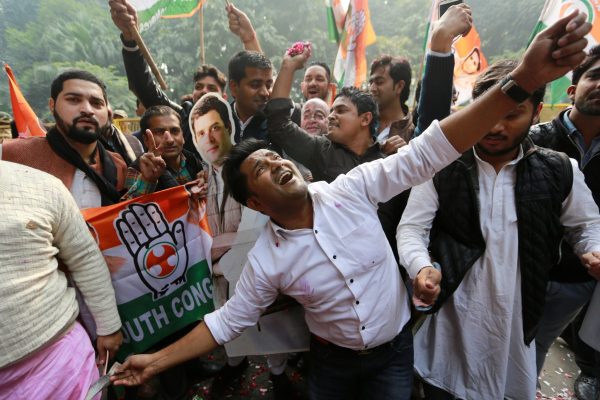This continuity is a useful reminder of India’s underlying political stability despite its fractured, raucous and often criminal politics.
The general election follows assembly elections in five states in late 2018 of which three (Rajasthan, Madhya Pradesh and Chhattisgarh) had particular interest. All three are part of the ‘Hindu heartland’, regarded as the core of the BJP’s base. The three are also significant in being contested primarily by the two national INC and BJP parties, without a major regional party to split the vote.
Election results were declared on 11 December. Congress will replace the BJP to form new state governments in the three states, although with narrow margins in both Rajasthan and Madhya Pradesh.
These results provide a much-needed boost for Rahul Gandhi, who was elected to succeed his mother Sonia Gandhi as Congress Party president in December 2017. Since then he has been the target of bitter personal attacks by Prime Minister Modi as symbolising the dynastic, elitist, westernised and corrupt politics of the INC. The electoral outcomes suggest that these attacks have not generated much traction.
India has also had a big year on the external front: the Trump administration’s sanctions on Iran (an important oil supplier for India); a new government in Pakistan with close links to the military; a volatile but increasingly dense, nuanced and contentious economic and security relationship with China; and shifting sentiments by portfolio investors against emerging markets.
But it is arguably domestic developments in banking and finance that have been the most significant theme over the past year.
Here, the landmark event was the terse, unexpected resignation of Urjit Patel from the post of Reserve Bank of India (RBI) governor on 10 December, citing personal reasons. Patel was an appointee of the Modi government and he departed overnight nine months before his three-year term was to end. The government moved quickly to name his replacement, Shaktikanta Das. Das is a recently retired civil servant with long experience in the Ministry of Finance (including at the time of India’s controversial reissue of currency in 2016, labelled demonetisation by the Indian press) and Modi’s sherpa for the G20 leaders summits.
Tensions between the Ministry of Finance and the Reserve Bank that had been brewing for at least a year burst into public view in October with an uncharacteristically public spat over the Bank’s policy independence. At the heart of the dispute is the appropriate approach to addressing deteriorating asset quality in India’s banks. Supervision and regulation of deposit-taking banks and (to a lesser degree) non-bank financial institutions lie with the Reserve Bank. While in principle such regulation is blind to ownership, some 70 per cent of commercial banking assets are held by public sector banks where the government holds the majority share.
Trying to get ahead of the curve, over the past two years the RBI has imposed increasingly stringent loan classification rules on all banks. This has particularly affected the public sector banks, revealing the erosion of their profitability and net worth. It also creates a need for additional capital, as the government struggles to maintain its majority equity stake. Resolution of impaired credit assets is also politically harder where publicly owned banks are concerned. There are allegations of connected lending, and any debt-relief is seen as a giveaway to political cronies.
The perception of corruption in bank lending decisions has been aggravated by recurring large frauds perpetrated on the publicly owned banks by absconding borrowers. Not surprisingly the government considers it the Bank’s responsibility to inspect the internal controls of all banks, while the Bank argues that, under the relevant statute, it lacks enforcement powers over them.
The puzzle behind Patel’s precipitate resignation is that, in most respects, the RBI and the government are aligned on key policy goals. To its great credit the Modi government has put in place bankruptcy legislation that has real bite in contrast to the shadowboxing of the past. Together with the RBI’s pressure on banks, this has finally led to changes in management control of defaulting companies. The RBI’s supervisory stance is consistent with international experience in limiting lending by zombie banks (prompt corrective action) and in seeking quick recapitalisation. While one can understand the nervousness of a government facing election in six months, flinching now threatens to undo the important progress that has been achieved.
The arrival of a seasoned bureaucrat as Reserve Bank governor should allow a refocus on these shared goals, taking politics out of lending and repayment and prompting the incoming government to revisit the need for majority control of the state-owned banks.
Suman Bery is a Non Resident Fellow at the Brussels-based think tank Bruegel and a Senior Fellow at the Mastercard Center for Inclusive Growth and is based in Delhi.
This article is part of an EAF special feature series on 2018 in review and the year ahead.

